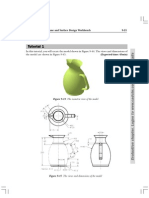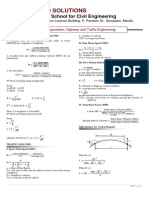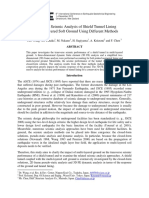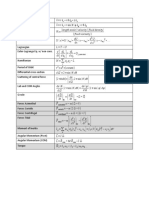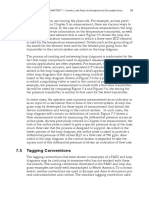x=rcosθ y=rsinθ r = x + y θ = tan y x
x=rcosθ y=rsinθ r = x + y θ = tan y x
Uploaded by
markosCopyright:
Available Formats
x=rcosθ y=rsinθ r = x + y θ = tan y x
x=rcosθ y=rsinθ r = x + y θ = tan y x
Uploaded by
markosOriginal Description:
Original Title
Copyright
Available Formats
Share this document
Did you find this document useful?
Is this content inappropriate?
Copyright:
Available Formats
x=rcosθ y=rsinθ r = x + y θ = tan y x
x=rcosθ y=rsinθ r = x + y θ = tan y x
Uploaded by
markosCopyright:
Available Formats
Statistics Fractiles Transportation Engineering Traffic Accident Analysis
Measure of Natural Tendency Range Design of Horizontal Curve Accident rate for 100 million
= 𝑙𝑎𝑟𝑔𝑒𝑠𝑡 𝑑𝑎𝑡𝑢𝑚 − 𝑠𝑚𝑎𝑙𝑙𝑒𝑠𝑡 𝑑𝑎𝑡𝑢𝑚 vehicles per miles of travel in a
Mean, x̅, μ → average
Minimum radius of curvature segment of a highway:
→ Mode Stat 1-var Coefficient of Range 2
→ Shift Mode ▼s Stat Frequency? on 𝑙𝑎𝑟𝑔𝑒𝑠𝑡 𝑑𝑎𝑡𝑢𝑚 − 𝑠𝑚𝑎𝑙𝑙𝑒𝑠𝑡 𝑑𝑎𝑡𝑢𝑚 v A (100,000,000)
= R= R=
→ Input 𝑙𝑎𝑟𝑔𝑒𝑠𝑡 𝑑𝑎𝑡𝑢𝑚 + 𝑠𝑚𝑎𝑙𝑙𝑒𝑠𝑡 𝑑𝑎𝑡𝑢𝑚 g(e + f) ADT ∙ N ∙ 365 ∙ L
→ AC Shift 1 var x̅ R → minimum radius of curvature
A → no. of accidents during period of analysis
Quartiles e → superelevation
f → coeff. of side friction or ADT → average daily traffic
Median, Me → middle no. when n is even
skid resistance N → time period in years
n+1 1 2 3 v → design speed in m/s L → length of segment in miles
Me th = Q1 = n Q2 = n Q3 = n g → 9.82 m/s2
2 4 4 4
Accident rate per million entering
1 n n when n is odd Centrifugal ratio or impact factor
Me th
= [( ) + ( + 1)] vehicles in an intersection:
2 2 2 1 1 1 2
Q1 = (n + 1) ; Q1 = (n + 1) ; Q1 = (n + 1) v A (1,000,000)
4 4 4 Impact factor = R=
Mode, Mo → most frequent gR
Interquartile Range, IQR
ADT ∙ N ∙ 365
R → minimum radius of curvature
Standard Deviation v → design speed in m/s A → no. of accidents during period of analysis
= 𝑙𝑎𝑟𝑔𝑒𝑠𝑡 𝑞𝑢𝑎𝑟𝑡𝑖𝑙𝑒 − 𝑠𝑚𝑎𝑙𝑙𝑒𝑠𝑡 𝑞𝑢𝑎𝑟𝑡𝑖𝑙𝑒
g → 9.82 m/s2 ADT → average daily traffic entering all legs
Population standard deviation = Q3 − Q1 N → time period in years
→ Mode Stat 1-var Power to move a vehicle
Coefficient of IQR Severity ratio, SR:
→ Shift Mode ▼ Stat Frequency? on P = vR
𝑙𝑎𝑟𝑔𝑒𝑠𝑡 𝑞𝑢𝑎𝑟𝑡𝑖𝑙𝑒 − 𝑠𝑚𝑎𝑙𝑙𝑒𝑠𝑡 𝑞𝑢𝑎𝑟𝑡𝑖𝑙𝑒
→ Input = P → power needed to move vehicle in watts f∙i
𝑙𝑎𝑟𝑔𝑒𝑠𝑡 𝑞𝑢𝑎𝑟𝑡𝑖𝑙𝑒 + 𝑠𝑚𝑎𝑙𝑙𝑒𝑠𝑡 𝑞𝑢𝑎𝑟𝑡𝑖𝑙𝑒 SR =
→ AC Shift 1 var σx v → velocity of vehicle in m/s
Q − Q1 R → sum of diff. resistances in N
f∙i∙p
= 3
Sample standard deviation
Q3 + Q1 f → fatal
Design of Pavement i → injury
→ Mode Stat 1-var Quartile Deviation (semi-IQR) = IQR/2 p → property damage
→ Shift Mode ▼ Stat Frequency? on Rigid pavement without dowels
→ Input Outlier Spacing mean speed, US:
→ AC Shift 1 var sx
→ extremely high or low data higher than 3W ∑d n
or lower than the following limits: t=√ Us = =
f ∑t ∑ 1
NOTE:
Q1 − 1.5IQR > x ( )
If not specified whether population/sample U1
in a given problem, look for POPULATION. Q 3 + 1.5IQR < x Rigid pavement with dowels
Coefficient of Linear Correlation Time mean speed, Ut:
Decile or Percentile 3W 3W
or Pearson’s r d
m t=√ t=√ ∑
im = (n) 2f 4f ∑ U1
→ Mode Stat A+Bx
10 or 100 Ut = t =
→ Input (at the edge) (at the center) n n
→ AC Shift 1 Reg r t → thickness of pavement Ʃd → sum of distance traveled by all vehicles
Normal Distribution W → wheel load Ʃt → sum of time traveled by all vehicles
NOTE: f → allow tensile stress of concrete Ʃu1 → sum of all spot speed
-1 ≤ r ≤ +1; otherwise erroneous 1/Ʃu1 → reciprocal of sum of all spot speed
Flexible pavement n → no. of vehicles
Population standard deviation
W Rate of flow:
Variance t=√ −r
Z-score or
standard score → Mode Stat 𝜋f1 q = kUs
standard deviation = σ
or variate → AC Shift 1 Distr f1 → allow bearing pressure of subgrade q → rate of flow in vehicles/hour
variance = σ2 r → radius of circular area of contact
left of z → P( k → density in vehicles/km
x−μ between wheel load & pavement
relative variability = σ/x z= uS → space mean speed in kph
σ right of z → R(
Mean/Average Deviation bet. z & axis → Q( Thickness of pavement in terms Minimum time headway (hrs)
x → no. of observations
μ → mean value, x̅ → Input of expansion pressure = 1/q
Mean/average value σ → standard deviation expansion pressure
t= Spacing of vehicles (km)
b pavement density
1 = 1/k
mv = ∫ f(x)dx Exponential Distribution
b−a a Stiffness factor of pavement
Peak hour factor (PHF)
P(x ≥ a) = e−λa = q/qmax
Mean value
P(x ≤ a) = 1 − e−λa
Es 3 s
SF = √
1 b P(a ≤ x ≤ b) = e−λa − e−λb Ep
RMS = √ ∫ f(x)2 dx ES → modulus of elasticity of subgrade
b−a a EP→ modulus of elasticity of pavement
Discrete Probability Distributions Walli’s Formula
π
Binomial Probability Distribution 2 [(m − 1)(m − 3)(m − 5) … (1 or 2)][(n − 1)(n − 3)(n − 5) … (1 or 2)]
P(x) = C(n, x) p q x n−x ∫ cosm θ sinn θ dθ = ∙α
0 (m + n)(m + n − 2)(m + n − 4) … (1 or 2)
where:
p → success NOTE:
q → failure
α = π/2 for m and n are both even
Geometric Probability Distribution α =1 otherwise
x−1
P(x) = p(q ) Tip to remember:
Fibonacci Numbers
Poisson Probability Distribution 𝑥2 − 𝑥 − 1 = 0
n n
x −μ 1 1 + √5 1 − √5 Mode Eqn 5
μ e
P(x) = an = [( ) −( ) ]
x! √5 2 2 𝑥=
1 ± √5
2
Period, Amplitude & Frequency
x = r cos θ
Period (T) → interval over which the graph of y = r sin θ
function repeats r = x2 + y2
Amplitude (A) → greatest distance of any point y
on the graph from a horizontal line which passes θ = tan−1
halfway between the maximum & minimum
x
values of the function
Frequency (ω) → no. of repetitions/cycles per unit
of time or 1/T
Function Period Amplitude
y = A sin (Bx + C) 2π/B A
y = A cos (Bx + C) 2π/B A
y = A tan (Bx + C) π/B A
You might also like
- CATIA - Wireframe and Surface Design ExercisesDocument20 pagesCATIA - Wireframe and Surface Design ExercisesNavdeep Singh Sidhu80% (20)
- Assignmet 2Document2 pagesAssignmet 2brady katayiNo ratings yet
- Review Innovations: Civil Engineering November 2020 Transportation Engineering 1Document2 pagesReview Innovations: Civil Engineering November 2020 Transportation Engineering 1Keziah Reuel Tangalin100% (1)
- 09-Circular Motion - 240531 - 182507Document2 pages09-Circular Motion - 240531 - 182507mintuchakraborty.2014No ratings yet
- Transportation EngineeringDocument2 pagesTransportation EngineeringJon SnowNo ratings yet
- Review Innovations: Civil Engineering November 2020 Transportation Engineering 1Document2 pagesReview Innovations: Civil Engineering November 2020 Transportation Engineering 1Krysha RomaineNo ratings yet
- 7-Clase de Vibraciones y El MedioDocument50 pages7-Clase de Vibraciones y El MedioalejandrobolattiNo ratings yet
- Lesson 28 and 29 - Isentropic Flow With Area Change - Handout VersionDocument16 pagesLesson 28 and 29 - Isentropic Flow With Area Change - Handout VersionjacksayshiNo ratings yet
- Banking of RoadDocument25 pagesBanking of RoadmohammadhamidakhlaqueNo ratings yet
- Modelling Navigation in Muddy Areas Through Captive Model Tests (Delefortrie Et Al. 2005)Document15 pagesModelling Navigation in Muddy Areas Through Captive Model Tests (Delefortrie Et Al. 2005)Marco SoteloNo ratings yet
- 3+formulas Add Elex CircuitsDocument7 pages3+formulas Add Elex CircuitsMark kervin natividadNo ratings yet
- Motion cueing algorithms for a real-time automobile driving simulatorDocument12 pagesMotion cueing algorithms for a real-time automobile driving simulatorhsguanNo ratings yet
- Lecture 1Document8 pagesLecture 1Khang DangNo ratings yet
- Estimación de Lluvia A Partir de Radioenlaces de Telecomunicaciones en Uruguay: Primeros AvancesDocument13 pagesEstimación de Lluvia A Partir de Radioenlaces de Telecomunicaciones en Uruguay: Primeros AvancesSemana de la Innovación en América100% (1)
- On Ramp Formula ChartsDocument2 pagesOn Ramp Formula ChartsdavitmatNo ratings yet
- ReviewDocument5 pagesReviewLenielle AmatosaNo ratings yet
- Automobile Problem SolutionsDocument110 pagesAutomobile Problem SolutionsNagarajanNo ratings yet
- Unit3 Iir Design Lecture NotesDocument24 pagesUnit3 Iir Design Lecture NotesramuamtNo ratings yet
- 123 MT 2 EQsDocument2 pages123 MT 2 EQsspritdummyNo ratings yet
- 5Document14 pages5ANDREYY GORYACHEVNo ratings yet
- Licentiate ThesisDocument116 pagesLicentiate Thesissoxisor130No ratings yet
- 40919-02 LIfting LugDocument12 pages40919-02 LIfting Lugkarthickeyanclass4No ratings yet
- MATH FormulasDocument38 pagesMATH FormulasEarl John JaymaNo ratings yet
- Circular MotionDocument3 pagesCircular Motiongokulkrishna2k7No ratings yet
- BTL_Machine Element (1)Document18 pagesBTL_Machine Element (1)Nguyen DangtrinhNo ratings yet
- Talkrenyi 3Document19 pagesTalkrenyi 3Srivatsan BalakrishnanNo ratings yet
- MAE331 Lecture 3Document32 pagesMAE331 Lecture 3Allen John100% (1)
- CLUTCHDocument6 pagesCLUTCHAboud MNo ratings yet
- Pof Perf FormulasDocument4 pagesPof Perf FormulasjfvanhannenNo ratings yet
- Rotation Equations Cheat SheetDocument1 pageRotation Equations Cheat SheetRoberto MartinezNo ratings yet
- Appendix K Al2Document9 pagesAppendix K Al2Erni MarianaNo ratings yet
- SET a.6 Transportation EngineeringDocument29 pagesSET a.6 Transportation EngineeringHwang YedangNo ratings yet
- Moment of Inertia and TorqueDocument12 pagesMoment of Inertia and TorqueMary Rhose VidalloNo ratings yet
- Current ElectricityDocument23 pagesCurrent Electricitygreeshmasri2019No ratings yet
- AFM Formula SheetDocument15 pagesAFM Formula Sheetganesh bhaiNo ratings yet
- SIM2LUDocument20 pagesSIM2LUkumarfirst317No ratings yet
- Cambridge International AS & A Level: PHYSICS 9702/04Document26 pagesCambridge International AS & A Level: PHYSICS 9702/04sinting lim100% (1)
- Trans CCDocument10 pagesTrans CCaashish.191802No ratings yet
- Suspension-Formula CheatSheet 03Document1 pageSuspension-Formula CheatSheet 03Sr. PolestarNo ratings yet
- Adobe Scan Mar 19, 2024Document9 pagesAdobe Scan Mar 19, 2024Rohith PrakashNo ratings yet
- Torque - Slip Characteristic of A Three - Phase Induction MachineDocument28 pagesTorque - Slip Characteristic of A Three - Phase Induction MachineAli AltahirNo ratings yet
- Circular Motion: T 2π r T holdsDocument13 pagesCircular Motion: T 2π r T holdsUti MichaelNo ratings yet
- Day 05Document9 pagesDay 05g.sathyanarayanan252008No ratings yet
- Ey TFormulasDocument1 pageEy TFormulasRegina E. FloresNo ratings yet
- Purdue PHYS 241 Final Exam Crib Sheet - Optics and AC CircuitsDocument1 pagePurdue PHYS 241 Final Exam Crib Sheet - Optics and AC CircuitsDaniel MNo ratings yet
- Wang 120.00Document10 pagesWang 120.00shachen2014No ratings yet
- Useful Aerospace FormulasDocument1 pageUseful Aerospace FormulasRadj90No ratings yet
- Super Physics O Level Formula SheetDocument2 pagesSuper Physics O Level Formula SheetUsateo TeoNo ratings yet
- 2-Straight Level Flight LecturesDocument75 pages2-Straight Level Flight LecturesQuang LinhNo ratings yet
- Modulus of Rigidity DoneDocument5 pagesModulus of Rigidity DoneSujay Das SonuNo ratings yet
- PreAcaMath 18S0 Lecture1 - 0 PDFDocument2 pagesPreAcaMath 18S0 Lecture1 - 0 PDFKaveesha DinamiduNo ratings yet
- Exam Grade12 2011 Ma FsDocument1 pageExam Grade12 2011 Ma FsIsrael PopeNo ratings yet
- Lifting Lug Calc1Document12 pagesLifting Lug Calc1Rajasekar MeghanadhNo ratings yet
- NeoclassicalDocument44 pagesNeoclassicalusafi5428No ratings yet
- 3.motion in A PlaneFormulae SheetDocument3 pages3.motion in A PlaneFormulae SheetNidhiVermaNo ratings yet
- Physics Complete Formula Revision (New)Document68 pagesPhysics Complete Formula Revision (New)manas singhNo ratings yet
- Chapter 1 - Rotational Dynamics NumericalDocument13 pagesChapter 1 - Rotational Dynamics NumericalAakash AhujaNo ratings yet
- JavaProp Users GuideDocument69 pagesJavaProp Users GuideNurhayyan Halim RosidNo ratings yet
- ZTZMGob JDocument7 pagesZTZMGob JObert MupomokiNo ratings yet
- AEP 3330 Final - Some EquationsDocument1 pageAEP 3330 Final - Some EquationsJesse ZhangNo ratings yet
- The Spectral Theory of Toeplitz Operators. (AM-99), Volume 99From EverandThe Spectral Theory of Toeplitz Operators. (AM-99), Volume 99No ratings yet
- Power Layout Mark Leandrow E. Bacolod Bsce 4A Bicol University Collegeof EngineeringDocument4 pagesPower Layout Mark Leandrow E. Bacolod Bsce 4A Bicol University Collegeof EngineeringmarkosNo ratings yet
- Round 5 - Questions PDFDocument12 pagesRound 5 - Questions PDFmarkosNo ratings yet
- Lecture DynamicsDocument13 pagesLecture DynamicsmarkosNo ratings yet
- LetterDocument2 pagesLettermarkosNo ratings yet
- Flow Routing: Reading: 8.1, 8.4, 9.1, 9.2Document12 pagesFlow Routing: Reading: 8.1, 8.4, 9.1, 9.2markosNo ratings yet
- Chapter 1 PDFDocument24 pagesChapter 1 PDFmarkosNo ratings yet
- Aggregates and Grain Size Analysis: Ogie 2011Document32 pagesAggregates and Grain Size Analysis: Ogie 2011markosNo ratings yet
- Online Preboard Math PDFDocument4 pagesOnline Preboard Math PDFmarkos0% (1)
- Reservoir RoutingDocument32 pagesReservoir Routingmarkos100% (1)
- 75 Bible Verses That Will Got You Through Civil Engineer's Licensure ExaminationDocument12 pages75 Bible Verses That Will Got You Through Civil Engineer's Licensure ExaminationmarkosNo ratings yet
- 75 Bible Verses That Will Got You Through Civil Engineer's Licensure ExaminationDocument12 pages75 Bible Verses That Will Got You Through Civil Engineer's Licensure ExaminationmarkosNo ratings yet
- 039 064 PDFDocument26 pages039 064 PDFMakaraSoyNo ratings yet
- Leaf Project DocumentDocument52 pagesLeaf Project DocumentKarthi KeyanNo ratings yet
- ML and Deep Learning SyllabusDocument3 pagesML and Deep Learning SyllabusPadmini PalliNo ratings yet
- Physics MCQDocument13 pagesPhysics MCQharshanauocNo ratings yet
- Data Interpretation Practice Exercise: Ref: DEX1162001Document3 pagesData Interpretation Practice Exercise: Ref: DEX1162001Deepankar Sadhan BanikNo ratings yet
- Team Beam Technical Report FinalDocument20 pagesTeam Beam Technical Report Finalapi-303131730100% (1)
- Module 1 Lesson 2 Integration Concept and FormulasDocument14 pagesModule 1 Lesson 2 Integration Concept and FormulasJobel CabahugNo ratings yet
- Course Number: STA 240 Course Name: Statistics Course Instructor: Tamanna Siddiqua Ratna. (Lecturer)Document39 pagesCourse Number: STA 240 Course Name: Statistics Course Instructor: Tamanna Siddiqua Ratna. (Lecturer)RupalNo ratings yet
- A GMM Approach For Dealing With Missing DataDocument41 pagesA GMM Approach For Dealing With Missing DataraghidkNo ratings yet
- Transportation Engineering - Lab ReportDocument14 pagesTransportation Engineering - Lab ReportlearnafrenNo ratings yet
- Musical Heart Melody Among Teenagers: AP Statistics Culminating ProjectDocument9 pagesMusical Heart Melody Among Teenagers: AP Statistics Culminating Projectapi-281094555No ratings yet
- Mathematics Thesis StatementDocument6 pagesMathematics Thesis Statementbsq1j65w100% (2)
- Van Der Heijden Image Based Measurement Systems - Object Recognition and Parameter Estimation (Wiley)Document343 pagesVan Der Heijden Image Based Measurement Systems - Object Recognition and Parameter Estimation (Wiley)Wonde Bog100% (2)
- Dynamic Model Analysis of Three Phase Induction Motor Using Matlab SimulinkDocument6 pagesDynamic Model Analysis of Three Phase Induction Motor Using Matlab SimulinkSuhail Ahmad SuhailNo ratings yet
- Solving Quadratic Equation by Factoring DLPDocument12 pagesSolving Quadratic Equation by Factoring DLPLealyn IbanezNo ratings yet
- Solved SSC CHSL 12th April 2021 Shift-2 Paper With SolutionsDocument33 pagesSolved SSC CHSL 12th April 2021 Shift-2 Paper With SolutionsNeel ShahNo ratings yet
- Omega 1 CKDocument2 pagesOmega 1 CKnusretcerenNo ratings yet
- Numerical DifferentiationDocument20 pagesNumerical Differentiationwanmustafa187No ratings yet
- Ex0 Questions SolutionsDocument7 pagesEx0 Questions SolutionsBiniyam haileNo ratings yet
- ITE 1122 - Fundamental ClassesDocument15 pagesITE 1122 - Fundamental ClassesDK White LionNo ratings yet
- Forces 4 MSDocument3 pagesForces 4 MSLutfi HidayatNo ratings yet
- NLC Math 3 Intervention LP v.1Document80 pagesNLC Math 3 Intervention LP v.1ROSARIO BARRION100% (1)
- Model: 2 XX Xy 2 Yy X 2 yDocument5 pagesModel: 2 XX Xy 2 Yy X 2 ythirumalNo ratings yet
- Key Excel Functions: AND OR NOTDocument26 pagesKey Excel Functions: AND OR NOTbenj panganibanNo ratings yet
- Ingenieria de ControlesDocument91 pagesIngenieria de ControlesJulio César Millán BarcoNo ratings yet
- Quiz1 CryptographyDocument9 pagesQuiz1 CryptographyAlok GaurNo ratings yet
- 7.5 Tagging Conventions: Chapter 7 - C F I DDocument18 pages7.5 Tagging Conventions: Chapter 7 - C F I DN MlynNo ratings yet
- Famous MathematiciansDocument15 pagesFamous Mathematiciansshiela mae ucangNo ratings yet
- Aerodynamic Analysis of A Car PDFDocument110 pagesAerodynamic Analysis of A Car PDFdhirendarji100% (1)
